
●
Charge stripes found in a layered cobalt oxideStripe phases are a form of complex matter involving coupled spin and charge order. They are observed in certain copper oxide superconductors, as well as in nickelates and manganites. Some theoreticians believe that stripe fluctuations are important to the mechanism of superconductivity in the copper oxide family of high temperature superconductors. A key piece of evidence for this idea is the universal form of the magnetic spectrum of hole-doped copper oxide superconductors as measured by neutron scattering, which is in the shape of an hourglass. This type of spectrum emerges naturally from a stripe-ordered ground state.
In 2011, an insulating, layered cobalt oxide La5/3Sr1/3CoO4 was found to have an hourglass magnetic spectrum [A.T. Boothroyd et al., Nature 471, 341 (2011)]. At the time, there was indirect evidence for stripe order in this material, and the result was significant because it provided an experimental demonstration of how an hourglass spectrum could arise from a stripe-ordered ground state. However, direct evidence for the charge-stripe order has been missing until now. The apparent absence of stripes led to an alternative, stripe-free, model to explain the hourglass spectrum based on two types of short-range magnetic order in coexistence on the nanoscale.
In our new work, published in Nature Communications, we employed polarized neutron diffraction at the Institut Laue–Langevin to detect a signature of charge stripes in La5/3Sr1/3CoO4. The results show that the magnetic ground state is more complicated than initially thought, comprising a nanoscopic coexistence of (i) spin- and charge-stripe order and (ii) charge order in which Co2+ and Co3+ alternative like the black and white squares on a chess board. However, the measurements reinforce the stripe-model as the underlying mechanism for the hourglass magnetic spectrum in the cobaltates. The present results provide an experimental basis for theories that assume a ground state with static or slowly fluctuating stripes in order to explain the hourglass spectrum in cuprates.
Reference (open access): P. Babkevich et al., Nat. Commun. 7:11632 doi: 10.1038/ncomms11632
●
Ferroelectrics are insulating materials with an electrical polarisation that can be switched by an applied voltage. Ferroelectricity cannot occur in metals because it would be screened by the conduction electrons. In an article published in Nature Materials, we report the discovery of a new material called lithium osmate (LiOsO3) which remains a metal down to the lowest temperatures and yet undergoes a structural phase transition that is identical to the ferroelectric transition in the well-known ferroelectrics LiNbO3 and LiTaO3.
Using a variety of techniques, including neutron diffraction at the ISIS Facility, Oxfordshire, Yanfeng Guo, Andrew Princep and Andrew Boothroyd, together with co-workers from ISIS, Japan and China, found that the phase transition in LiOsO3 is characterised by a large shift in the position of the Li ions, a structural effect which has been known for many years to cause ferroelectricity in LiNbO3 and LiTaO3.
The discovery represents the first clear-cut example of a so-called “ferroelectric” metal, a concept first postulated over 50 years ago by Nobel prize-winner Philip Anderson and co-worker Blount. It is scientifically interesting because the mechanisms for structural phase transitions are usually quite distinct in metals and insulators, so it is surprising to find a metal (LiOsO3) that undergoes the same structural transition as occurs in the insulating analogues. The discovery of a “ferroelectric” metal establishes a new class of materials which could have interesting properties, possibility including non-centrosymmetric superconductivity stabilised by the “ferroelectric” structural instability.
Reference: Y. Shi et al. Nature Materials doi:10.1038/nmat3754
News & Views article: doi:10.1038/nmat3774
●
We are pleased to welcome Yanfeng into the group. Yanfeng was previously a postdoctoral fellow in the National Institute for Materials Science in Tsukuba, Japan, where he worked on synthesis, crystal growth and physical properties investigations of a range of transition metal oxides with exotic properties. Before that he completed his PhD at the Institute of Physics, Chinese Academy of Sciences, Beijing, on pulsed electron deposition of thin films of high temperature superconductors and their properties.
●
New EPSRC grant:Title: Emergence of novel electronic states in 5d transition metal oxides
Investigator(s): Prof. Andrew T. Boothroyd
Reference: EP/J017124/1
Value: £484,867
Start date: 24 September 2012
Duration: 3.5 years
●
Andrew Princep joins the groupWe welcome Andy into the group. Andy did his undergraduate degree at Curtin University in Western Australia, and recently completed his doctorate at the University of New South Wales, Canberra campus. His thesis work involved the use of synchrotron x-ray and neutron scattering experiments to investigate orbital and magnetic order in rare-earth borocarbides.
●
IoP Superconductivity Group Prize 2011We are proud that the work of the group has been recognised through this award to ATB.
●
New EPSRC grant:Title: The control of electrons through patterning of superstructures
Investigator(s): Prof. Andrew T. Boothroyd
Reference: EP/J012912/1
Value: £423,336
Start date: 1 March 2012
Duration: 3 years
● Physicists detect femtoscale atomic displacements in multiferroic materials
An international team, including Oxford physicists Dr D. Prabhakaran and Professor Andrew Boothroyd, has developed a novel X-ray technique for imaging atomic displacements in materials with unprecedented accuracy. They have applied their technique to determine how a recently-discovered class of functional materials known as multiferroics can develop magnetic order and a ferroelectric polarization simultaneously.
Multiferroics are candidate materials for new classes of electronic devices. The discovery is published in the
2 September 2011 issue of Science. Multiferroic materials combine both a ferroelectric polarization and some form of magnetic order.
If these two ordering phenomena are coupled then the material can be used in devices to control
electrical signals by magnetic fields, and vice versa. Interest in multiferroics was ignited in 2003
by the discovery of a strong multiferroic coupling in the insulating compound terbium manganite (TbMnO3).
The team measured the interference between polarized X-ray photons undergoing both charge and magnetic scattering processes. They studied a
single crystal of TbMnO3 grown in the Clarendon Laboratory, and were able to measure the displacements of specific atoms
within the compound with an accuracy approaching one femtometre (10–15 m), or 100,000 times smaller than the atoms themselves.
For more information, see
Femtoscale magnetically induced lattice distortions in
multiferroic TbMnO3
H.C. Walker, F. Fabrizi, L. Paolasini, F. de Bergevin,
J. Herrero-Martin, A.T. Boothroyd, D. Prabhakaran, and D.F. McMorrow
Science 333, 1273 (2011)
● Antiferromagnetic spin fluctuations and magnetic resonance in superconducting LiFeAs
For more information see:
Antiferromagnetic spin fluctuations in LiFeAs observed by neutron scattering
A. E. Taylor, M. J. Pitcher, R. A. Ewings, T. G. Perring, S. J. Clarke, and A. T. Boothroyd
Phys. Rev. B 83 (2011) 220514(R).
● New EPSRC grant:
Title: New approaches to iron-based superconductors
Investigator(s): Dr Simon J. Clarke, Prof. Dermot O'Hare,
Prof. Andrew T. Boothroyd and Prof. Stephen J. Blundell
Reference: EP/I017844/1
Value: £439,936
Start date: 1 June 2011
Duration: 3 years
● Origin of the hour-glass magnetic spectrum in high temperature superconductors
One of the intriguing features of the copper oxide high temperature superconductors, discovered in 1986 by Bednorz and Müller, is the existence of stripe-like patterns of spin and charge found on the planes of copper and oxygen atoms from which the crystal structure is built. Evidence has gradually accumulated over the past 15 years that the motions of these stripes may play a role in the formation of superconductivity, but efforts to probe their dynamical properties experimentally have been hampered by the weakness of the signal and by complications due to superconductivity.
In work reported in Nature on 17 March 2011, we studied a cobalt oxide compound from outside the family of the copper oxide superconductors but with a similar stripe-like magnetic pattern. Using neutron scattering facilities at the Institut Laue-Langevin in Grenoble, France, we probed the correlated motions of the atomic magnetic moments and found a magnetic spectrum which has the same appearance — in the shape of an hour-glass — as found universally in the copper oxide superconductors, providing strong evidence that fluctuating magnetic stripes cause the hour-glass spectrum in the copper oxide superconductors. The results suggest that magnetic stripes are a key ingredient in the function of the copper-oxide superconductors.
For more information see:
An hour-glass magnetic spectrum in an insulating, hole-doped antiferromagnet
A. T. Boothroyd, P. Babkevich, D. Prabhakaran and P. G. Freeman
Nature 471 (2011) 341–344
High-temperature superconductivity: The secret of the hour-glass
J. Zaanen
Nature 471 (2011) 314–316
● Magnetism and superconductivity in FeSexTe1–x
Two recent publications describe the results of combined neutron scattering and muSR investigations into the magnetic response in the FeSexTe1–x series of Fe-based superconductors. In the first paper1, muSR data as a function of composition uncovered evidence of a narrow composition window in which superconductivity coexists with static magnetic order. Neutron scattering revealed that the magnetic order is incommensurate in this coexistence region, with an ordering wavevector (0.46, 0, 0.5) — see upper image. In the second paper2, the magnetic fluctuations in a superconducting sample was measured and found to exhibit a superconductivity-induced resonance at an energy of 7 meV and at the commensurate antiferromagnetic wavevector (0.5, 0.5, 0) — see lower image. The existence of a resonance peak at this wavevector appears to be a characteristic feature of bulk superconductivity in the Fe-based superconductors.
[1] Coexistence of incommensurate magnetism and superconductivity in Fe1+ySexTe1–x R. Khasanov et al., Phys. Rev. B 80 (2009) 140511(R)
[2] Magnetic excitations of Fe1+ySexTe1−x in magnetic and superconductive phases P. Babkevich et al., J. Phys.: Condens. Matter 22 (2010) 142202.
● Magnetic monopoles created in condensed matter
A team from the Institut Laue-Langevin in Grenoble, University College London and Oxford report in a recent issue of the journal Science that they have detected magnetic fluctuations consistent with quasiparticles that behave like magnetic monopoles. The evidence was found in the interference pattern of neutrons scattered by a magnetic substance called 'spin ice'. The Oxford members of the team were D. Prabhakaran and A.T. Boothroyd. The particular contribution of our group was to prepare a very high quality single crystal of the spin-ice compound Ho2Ti2O7.
For more information see Magnetic Coulomb Phase in the Spin Ice Ho2Ti2O7 and Icy Journey Finally Uncovers Magnetic Monopole.
● New EPSRC/STFC grant:
Title: Magnetic correlations in superconducting iron arsenides
Investigator(s): Prof. A.T. Boothroyd and Dr S.J. Clarke
Reference: EP/G067457/1
Value: £142,528
Start date: 1 Oct 2009
Duration: 4 years
● Magnetic dynamics in the parent of a new
iron pnictide superconductor
One of the scientific highlights of 2008 was the discovery of a new family of high transition-temperature (Tc) superconductors containing iron. The new superconductors occur in several structure types all of which have in common layers of Fe bonded to a pnictide (As or P) or chalcogenide (Se or Te). Transition temperatures up to 56 K have been reported. It is widely believed that magnetic fluctuations may play a role in the mechanism of superconductivity.
In collaboration with Dr Simon Clarke (ICL, Oxford) and colleagues at the ISIS Facility we have been using neutron spectroscopy to learn about the fundamental magnetic interactions in these new materials. In a recent paper we showed that the spin excitations in the antiferromagnetically-ordered parent phase BaFe2As2 extend over a wide range of energy up to ~0.2 eV. This implies that spin fluctuations have sufficient energy to mediate high temperature superconductivity.
For more information see:
R.A. Ewings et al., Phys. Rev. B 78, 220501(R) (2008)
● Lecture at 6th PSI Summer School on Condensed Matter research, 18–25 Aug 07, Zuoz, Switzerland
Concepts of Neutron Scattering (1.5Mb)
● Presentation at Excitations User Meeting,
Abingdon 25 July 2007
LET Overview (1.3Mb)
● Scientific highlight in ILL Annual Report 2007
In recent years, a debate has raged about the nature of the spin and charge order found in certain copper oxide superconductors. The existence of a stripe phase consisting of alternating regions of antiferromagnetic and charge order has been widely discussed for many years, but other patterns of spin and charge order have also been postulated, such as spiral and checkerboard patterns.
We used polarised neutron diffraction to investigate the magnetic order in Nd-doped LSCO at a doping level of 1/8. We found that the magnetic order in this material is either (i) one-dimensionally modulated and collinear (upper figure), consistent with the stripe model, or (ii) two-dimensionally modulated with a novel noncollinear structure (lower figure). The experiment conclusively ruled out a number of other proposed magnetic structures, such as in-plane spiral and modulated checkerboard order.
For more information, see Magnetism in a charge-ordered superconductor and Phys. Rev. Lett. 98, 197003 (2007).
Also, see poster presented at CMMP08, Royal Holloway College, 26–28 March 2008.

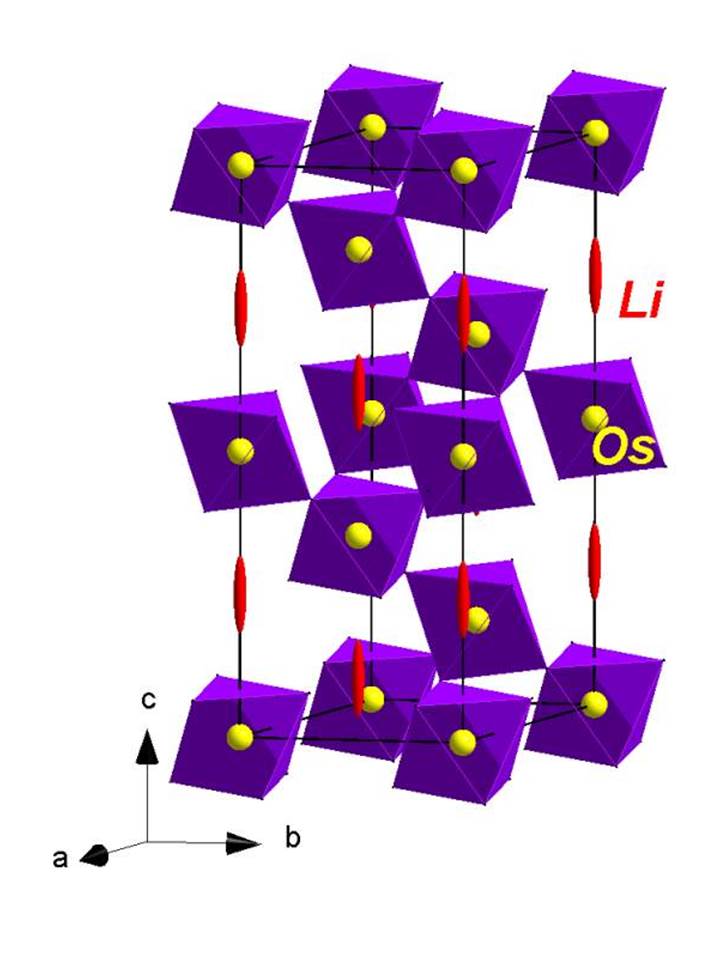
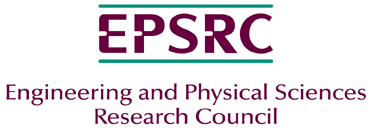





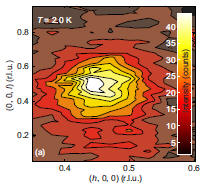
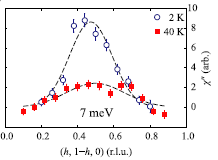
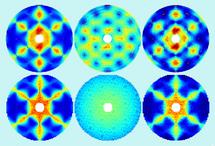

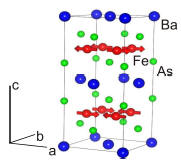
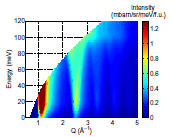
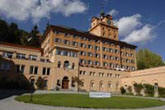
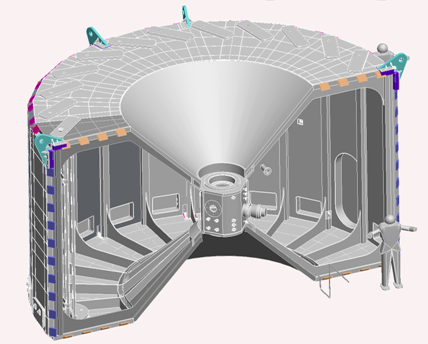
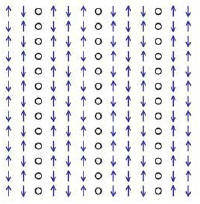
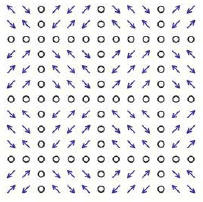
Prof. Andrew Boothroyd
Clarendon Laboratory
Oxford, OX1 3PU
United Kingdom
phone
+44 (0) 1865 272376
fax
+44 (0) 1865 272400